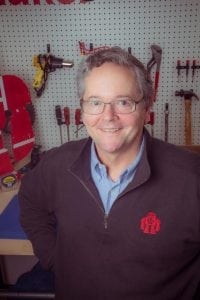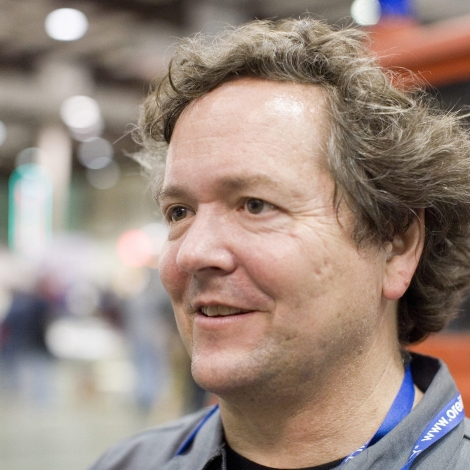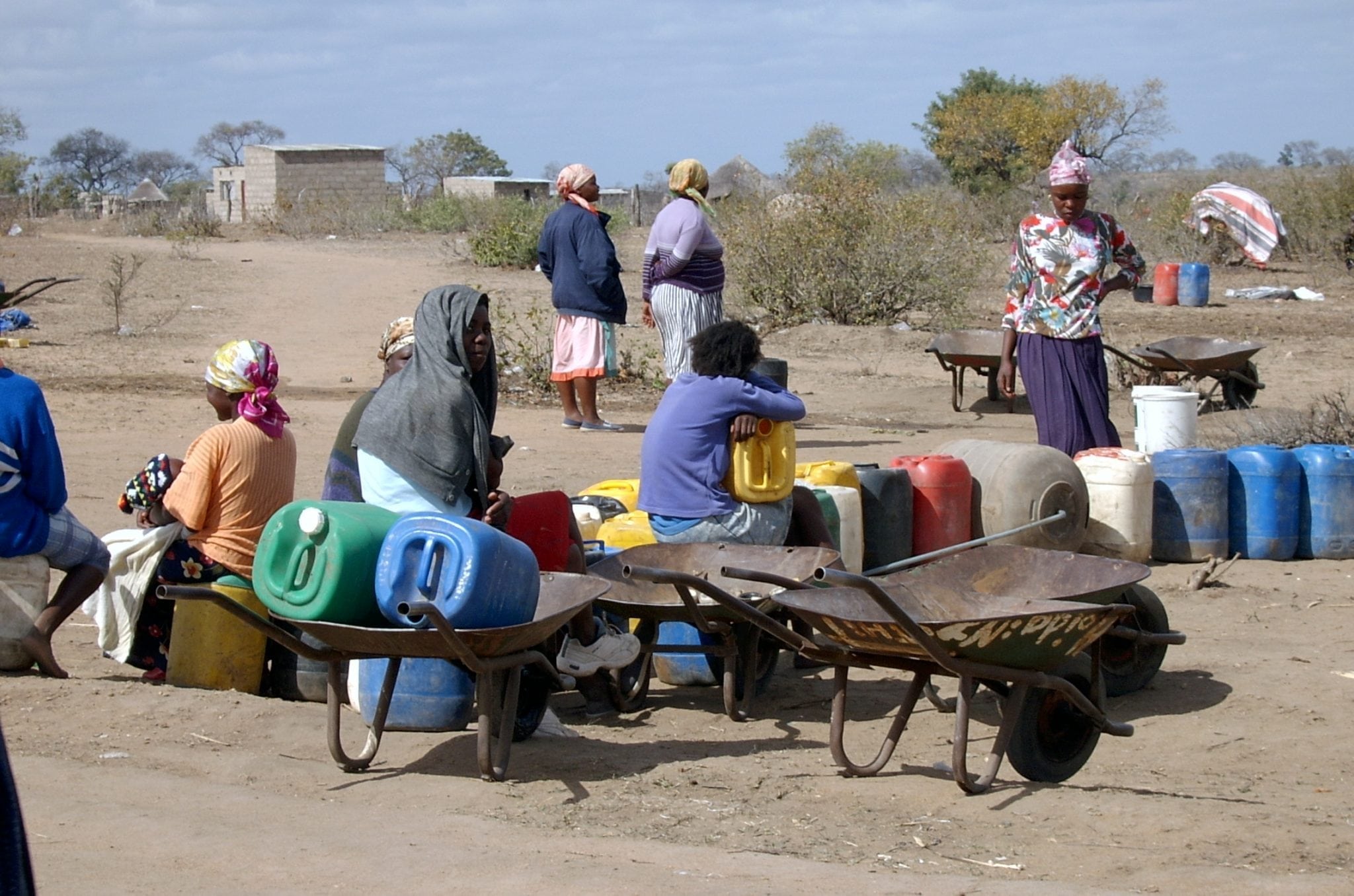 Dale Dougherty has traveled the world taking part in Maker Faires, which his company Maker Media organizes. Called the “father” of the maker movement, Mr. Dougherty founded his media company and has published MAKE:, the quarterly magazine fo do-it-yourself projects, since 2005. With Maker Faires now held in dozens of cities, from Beijing, China to Accra, Ghana and of course in the Bay Area of the United States where it all started, Mr. Dougherty seems particularly well informed about DIY culture in international development and work for the social good. We asked Dale Dougherty five questions.
Dale Dougherty has traveled the world taking part in Maker Faires, which his company Maker Media organizes. Called the “father” of the maker movement, Mr. Dougherty founded his media company and has published MAKE:, the quarterly magazine fo do-it-yourself projects, since 2005. With Maker Faires now held in dozens of cities, from Beijing, China to Accra, Ghana and of course in the Bay Area of the United States where it all started, Mr. Dougherty seems particularly well informed about DIY culture in international development and work for the social good. We asked Dale Dougherty five questions.
E4C: What role does the DIY movement play in the creation of products that meet basic needs in underserved communities?
DD: The availability of rather cheap hardware components and free software has made it easier and more affordable for anyone with an idea to make something. Comercial innovation is driven largely by market opportunity — if I make something, how many people will buy it? Big companies want to develop products for large markets. Their focus on market size means that many smaller opportunities are open as niche markets. Makers tend not to think of market size but rather their own need or interest in developing a project, which might one day turn into a product.
One might say that if the “market” doesn’t produce what you need, then you can make it yourself. But you can’t do it by yourself.
Underserved communities have unmet needs. So, what if we can empower people to become makers to solve their own problems and create inexpensive solutions that can be utilized by many others? There doesn’t have to even be a business model for those solutions to exist and spread; what you need is to create the community. One might say that if the “market” doesn’t produce what you need, then you can make it yourself. But you can’t do it by yourself.
Makers have learned from open source software, which provided free software that could be used to address niche markets, markets that larger software companies didn’t consider valuable. A developer could use open source software as a standard component in a solution and most importantly, the software came with a community of people who were helpful and supportive of others using the software. Now, open source hardware is doing the same by defining standard hardware components that can be used across a wide variety of applications, and it is backed by a community that shares its knowledge openly. Both hardware and software are democratizing technology and opening up the process of innovation to almost anyone.
E4C: What are some of the technologies that you consider as enablers of social innovation?
DD: First there are microcontrollers in all form factors that provide the computing brain behind applications that interact with people and the physical world. Microcontrollers such as Arduino are not only inexpensive but they are fairly easy to learn. The “brains” become components in machines such as 3D printers, drones and scientific instrumentation. So it’s not just the technology itself but it is the people that are able to harness the technology that makes a big difference for social innovation.
In many ways, software is the hidden enabler of hardware innovation because it reduces the amount of knowledge and experience required to be productive.
Second, digital fabrication technologies such as 3D printers and laser cutters are a revolution in physical prototyping. That means it costs less to create a physical model that you can test and share with others to get feedback. Because the costs are lower, you can make only one of something and you can iterate over a design many times without needing a large budget. Moreover, access to digital fabrication machines is increasingly possible in almost any city through Fab Labs and makerspaces. Virtually anyone can walk in one of these space and use these machines for their own purposes. Often, when they do that, they realize that there’s a community of people doing similar things and they can be part of the community.
Third, computer-aided design software (CAD) is reducing the cost and complexity of designing new things. CAD software, like video editing software in the past, was the realm of professionals. Now these tools are more accessible to amateurs and even novice can make rapid progress. In many ways, software is the hidden enabler of hardware innovation because it reduces the amount of knowledge and experience required to be productive.
You can undertake important missions, working alongside others, and solve problems that might be never be solved by corporations or governments.
Fourth, new programming tools and frameworks that make it easier for more people to write code and provide access to cloud-based libraries that perform complex “AI” operations. For instance, from a Raspberry PI equipped with a camera, you can write programs that access AI libraries in the cloud to do visual recognition of faces or objects. The complex processing is done in the cloud, not on the RPi. Microsoft has released Make Code, a block programming language in the style of Scratch, that integrates wonderfully with hardware platforms like MicroBit. All this means that a very small device can be connected, customized and very powerful.
If you have the training to use these tools, think of the many unsolved problems you might address and that can be what I call “Missions for Makers.” You can undertake important missions, working alongside others, and solve problems that might be never be solved by corporations or governments.
E4C: With an emphasis on products that serve the underserved, what trends and challenges do you see in the DIY community?
DD: The important trend I see is developing open communities. What I mean is that if a group of people begin collaborating on solving a problem, it is as much about the powers gained by that community as it is about the products they generate. A community is a living thing that learns to develop and support a product and keep it alive. That seems to be an important advantage and it’s sometimes lost on companies.
A community is a living thing that learns to develop and support a product and keep it alive.
You need technology to solve problems but you need to build and organize open and inclusive learning communities that are invested in the problems and solutions. In the community, you can tap skill sets for design, research, collaboration and communication as well as technical expertise. Sharing is what makes the communities work, and the maker community as a whole.
Also, I emphasize community because it’s the community organizing to serve its members, not a few people figuring out how to serve the underserved as customers. We should want to help people help themselves and empower the people who know the problems well to be the problem solvers. Productive communities create impact.
E4C: In your travels what are some of the interesting projects you have seen that represent the DIY spirit in social innovation?
DD: Hannah Edge is a 14-year old high school student who developed a 3D-printed spirometer that connects to her cellphone to display a report. She had to explain to me what a spirometer is — it measures intake and outtake of air from your lungs. When I asked her why she developed it, she said she had asthma and when she went to the doctor, they used a spirometer to test her breathing. She wished she could do that test at home, and not finding one that she could afford to own, she set out to design and build a spirometer for herself. She believes that others have the same problem. (www.spiroedge.com)
The people in need of 3D-printed prosthetic hands, who are often young kids, can create a design that fits them exactly
E-Nable is a community that brings together people who share designs for 3D-printed prosthetics as well as people in need of prosthetics. I think of it as the traditional manufacturers of prosthetics might offer S,M,L sizes in two colors. The people in need of 3D-printed prosthetic hands, who are often young kids, can create a design that fits them exactly, and can be changed as they grow. They also typically decorate their hands with logos or superhero emblems that transforms a functional device into something they are proud to wear.
E4C: You’re a member of the African Robotics Network, which we have written about at E4C. Would you mention a short list of other organizations that promote a DIY spirit in the service of global development?
DD: One is Tikkum Olam Makers, a group out of Tel Aviv that organizes Makeathons to develop assistive technology solutions. They bring together groups of makers with different skillsets and introduce them to a “need-knower”, a person with a specific problem or issue to address. What I like is that the focus is not on developing a product or a company, like a lot of hackathons. Rather, it is designed to solve one person’s very specific problem. For instance, a woman who was born without any limbs and has to pick up things with her mouth. How could you extend her ability to reach objects and grasp them? The team worked with her trying different solutions but she was there telling them what worked and what didn’t. At the end, she had something that she planned on using.
Instead of just importing solutions, they were training local people to design and create things they needed and could be produced on a 3D printer.
Another group is Field Ready that is leveraging technology to help people in disaster areas help themselves such as after the earthquake in Haiti. Instead of just importing solutions, they were training local people to design and create things they needed and could be produced on a 3D printer, things such as medical supplies which they could not easily obtain from outside their country. The point was to increase the capabilities of the local people to solve their own problems rather than arriving with solutions for them.
Another project that I came across in Barcelona was Open Source Beehives. A group had develop and shared designs for building beehives and even a device to monitor the health of the hive to help more people raise bees.

